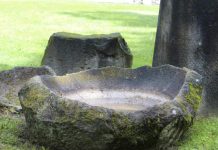The size of the Wood Warbler (Phylloscopus sibilatrix) is 12.5 cm in length. This warbler is a large, plump Phylloscopus of mature woodland, with comparatively long wings and a short tail. From below, the broad ‘shoulders’ and long undertail coverts contribute to the rather triangular, short-tailed look, an impression enhanced by the long primary projection.

In all plumages, the clear yellow supercilium, throat, and upper breast contrast with the clean white of the remainder of the underparts, even though in the shade of the tree canopy colors may appear subdued. The upper parts are bright olive-green, with yellower fringes to wing feathers and contrastingly dark centers to tertials (latter fringed with yellowish-white).
Both bill and legs are very pinkish. These features vary little and add up to a very distinctive bird compared with many members of the genus, so much so that the unwary might be misled into thinking it is a Hippolais, but the clear supercilium and relatively short, notched tail are typical Phylloscopus features.
Look out for bright yellowish Willow Warblers in fresh autumn plumage, which looks so unusual from spring and summer birds. Rare individuals of Wood warbler are noticeably duller, with grey-green upper parts and only a yellowish tinge to face and upper breast; these can be problematic, but size, shape, noticeably clean white lower breast to vent, dark-centered tertials with whitish fringes and pinkish bill and legs should assist identification.
The Wood warblers are true forest birds, feeding and singing within the upper layers of the woodland canopy, energetically flying from tree to tree and dropping to lower perches, before zooming upwards once more. These birds are tending to hop about in foliage with a rather crouched (Garden Warbler-like) posture. All plumages are similar, although in autumn adults have worn primaries, secondaries, and tail, which are fresh on first-year birds.

The call of Wood Warbler is a single mellow, rather plaintive ‘pew’. However, the song of Wood Warbler is distinguishing but compares to Bonelli’s Warbler. There are 2 types of songs that are freely uttered and interchanged: a prolonged melodious stuttering trill, starting slowly, then accelerating before ending in metallic shivering (‘zip zip zip zip-zip-zip-zip-zip-zizizizizwirrrrrrr’); and a descending clear, mellow ‘pew-pew-pew-pew-pew’ (a repetition of the call note).
Wood Warbler is locally a common bird. But mature deciduous and mixed woodlands with closed canopy and little or no undergrowth, frequently in hilly terrain. On passage (rare on the southbound leg) will also resort to bushy areas, but less so than other Phylloscopus. Here you can read more about other warblers.







